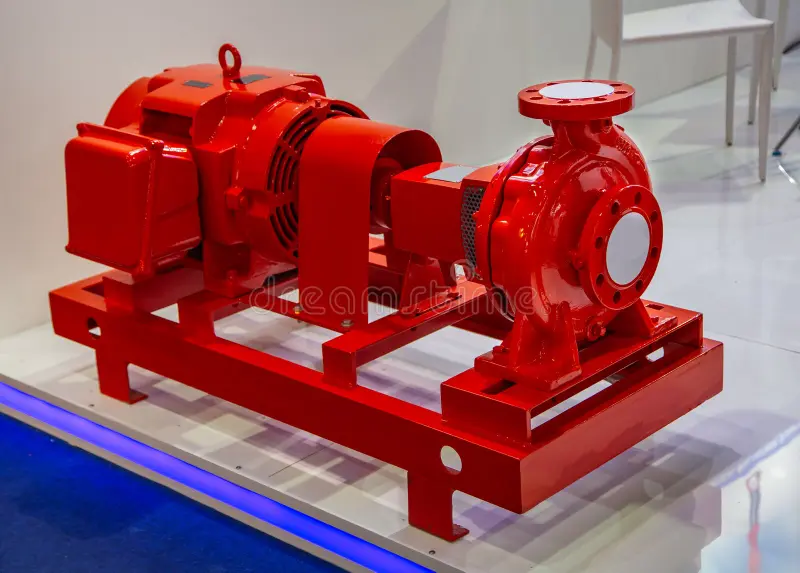Table of Contents
Introduction to Fire Water Pumps
Fire water pumps are crucial for fire suppression, ensuring that water can be delivered rapidly and at high pressure to combat fires in various settings. Whether installed in residential complexes, industrial facilities, or commercial buildings, these pumps are designed to move large volumes of water to sprinkler systems or fire hoses when the need arises. Fire water pumps are typically part of a larger fire protection system and act as the backbone of firefighting infrastructure, providing reliable and consistent water flow to contain and extinguish fires before they spread. Understanding their function, types, and maintenance requirements is essential for anyone responsible for fire safety.
Types of Fire Water Pumps
There are several types of fire water pumps, each suited for different applications and environments. The most common types are:
- Centrifugal Pumps – These pumps are widely used in fire systems due to their reliability and ability to handle high flow rates. Centrifugal fire pumps work by using an impeller to create pressure that moves water through the system. They are versatile and suitable for a variety of fire suppression setups.
- Vertical Turbine Pumps – Ideal for drawing water from underground sources, vertical turbine pumps are often used in areas without readily available water supplies. They are durable and provide high-pressure water delivery, making them suitable for large facilities or outdoor settings where water needs to be pulled from below ground.
- Positive Displacement Pumps – Although less common, these pumps are highly effective in situations requiring low water flow at high pressure. Positive displacement pumps move water by trapping a specific volume and displacing it through the outlet, making them suitable for specialized fire systems or confined environments.
Each pump type has specific advantages, and the choice depends on factors like the building’s size, layout, and proximity to water sources.
Benefits of Installing Fire Water Pumps
Fire water pumps offer several benefits that enhance safety and protection for buildings and occupants:
- Enhanced Fire Safety – By delivering high-pressure water to fire sprinklers and hoses, fire pumps ensure that suppression systems are highly effective. This immediate water supply can control fires before they escalate, minimizing damage and improving safety for everyone on the premises.
- Compliance with Safety Regulations – Most commercial and industrial buildings are required to install fire water pumps as part of their fire safety compliance. Meeting these standards is essential not only for occupant safety but also to avoid penalties and ensure that insurance coverage is valid.
- Reliability in Emergency Situations – Fire water pumps are designed for quick activation in emergencies, ensuring that water is readily available when needed. This reliability makes them a critical component of any fire protection system, providing peace of mind and reducing response time during fires.
- Extended Reach and Pressure – Many fire water pumps are designed to cover extensive areas and deliver water at high pressures. This capability allows them to supply water to high-rise buildings, remote locations, or large industrial spaces, ensuring that water can reach areas where traditional pressure sources might fall short.
Maintenance and Inspection Requirements
To keep fire water pumps in optimal condition, regular maintenance and inspection are necessary. These systems are often required by law to undergo routine checks to ensure they function correctly in emergencies. Key maintenance tasks include:
- Weekly Testing – Fire pumps typically undergo a weekly churn test, which involves running the pump without drawing water to check that all components are functional. This process helps identify any mechanical or electrical issues before they become serious.
- Annual Inspection – In addition to weekly tests, annual inspections are essential for a thorough evaluation of the pump’s performance. Professionals will check for wear, leaks, and the integrity of seals and couplings to ensure the pump is ready for operation.
- Battery and Fuel Checks – For diesel-powered fire pumps, fuel levels and battery power need to be monitored regularly. Ensuring that diesel pumps are fully fueled and that batteries are charged and in good condition is crucial, especially in facilities where power outages are a concern.
- Preventive Maintenance – Routine lubrication, parts replacement, and alignment adjustments are part of preventive maintenance. Keeping the pump’s moving parts well-maintained helps avoid breakdowns and ensures reliability when the pump is needed.
Regular maintenance not only extends the lifespan of fire water pumps but also guarantees their efficiency and effectiveness, offering a dependable line of defense against fire-related disasters.china fire fighting pump

